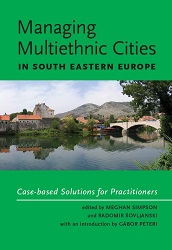Activities of the Fund for an Open Society–Serbia and the Center for Regionalism
Activities of the Fund for an Open Society–Serbia and the Center for Regionalism
Author(s): Tomislav Žigmanov
Subject(s): Politics / Political Sciences, Politics, Civil Society, Governance, International relations/trade, Inter-Ethnic Relations, Geopolitics
Published by: Centar za regionalizam
Keywords: Center for Regionalism; Open Society–Serbia; multiethnic local communities
Summary/Abstract: This last chapter provides an overview of a three-year-long project of the Fund for an Open Society–Serbia to develop and reach a morally-sustainable and ethno-culturally sensitive model of governance in multiethnic local communities in Serbia. It was implemented by three different local self-governments (Senta, Sombor, and Zrenjanin) in Vojvodina, in cooperation with the Center for Regionalism from Novi Sad and a group of experts engaged to assist with the project. The project began with an in-depth analysis of the existing status of local minority policies. The results were later the subjects of public discussions held in each local community. This was followed by a number of activities aimed at developing the capacities of local authorities and minority institutions and organizations for the creation and implementation of minority policies at the local level by means of education (round tables, consultations, organized trainings, and study tours). The target groups of these activities were the elected and appointed representatives of local, regional, and central administrative authorities, representatives of local minority institutions and NGOs, cultural and educational institutions, the media, etc. At the same time, various activities were undertaken in order to establish good models for minority policies in local communities. In this respect, the concrete problems and existing needs in given local communities first were defined, followed by the planned creation of the most adequate and optimal solutions, which had to observe the legal framework, interests, and needs of each particular minority community, as well as realistic possibilities for the local community concerned. Finally, the initiatives were defined, along with the manners of their articulation (models, procedures, system, etc.), which was followed by the implementation of the initiatives as one of the ways of resolving the problems.
Book: Managing Multiethnic Cities in South Eastern Europe Case-based Solutions for Practitioners
- Page Range: 185-198
- Page Count: 14
- Publication Year: 2010
- Language: English
- Content File-PDF

